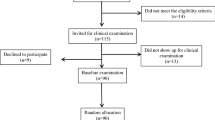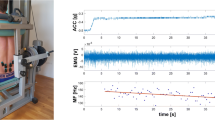Abstract
Study Design: A cross-sectional analytic study was conducted.
Objectives: To collect normative data on back extensor endurance holding times and evaluate the discriminative validity of the Biering–Sorensen test in a group of coal miners in Australia.
Summary of Background Data: Low back pain is a common complaint among those working in the Australian coal mining industry. One test that may be predictive of first-time episodes of low back pain is the Biering–Sorensen test of back extensor endurance strength. While this test has been evaluated in overseas sedentary populations, normative data and the discriminative ability of the test have not been evaluated with coal miners.
Methods: Eighty-eight coal miners completed a questionnaire for known risk factors for low back pain, performed the Biering–Sorensen test, and undertook a test of aerobic fitness. Data analysis was performed to describe the groups and to determine whether any significant difference existed between those with a past history of low back pain and those without.
Results: Significantly lower than expected holding times were found in this group of coal miners (mean 113 s). This result was significantly lower than demonstrated in previous studies (mean 138 s, t 87 = 6.32, p < 0.001). When holding times for those with a past history of low back pain were compared with times for those with no history of low back pain, the difference was not statistically significant (t 86 = 1.56, p = 0.12), nor was there a significant difference in fitness between those with a past history of low back pain and those without (t 86 = 0.47, p = 0.64).
Discussion/Conclusions: Coal miners in Australia have lower than normal Biering– Sorensen holding times. This lower back holding time does not differ between coal miners with a past history of low back pain and those without.
Similar content being viewed by others
REFERENCES
NSW Workers Compensation Statistical Bulletin 1998–1999. Workcover Authority of New South Wales.
Biering-Sorensen, F. Physical measurements as risk indicators for low-back trouble over a one year period. Spine 1984; 9: 106–119.
Bigos S, Bowyer O, Braen G. Acute low back problems in adults. Clinical practice guideline No.14. Agency for Health Care Policy and Research, Public Health Service, USA, 1994.
Seidel H, Bayer H, Brauer D. Electromyographic evaluation of back muscle fatigue with repeated sustained contractions of different strengths. Eur J Appl Physiol 1987; 56: 592–602.
Luoto S, Heliovaara M, Huuri H, Alaranta H. Static back endurance and the risk of low back pain. Clin Biomech 1995; 10: 323–324.
Hultman G, Nordin M, Saraste H, Ohlsen H. Body Composition, endurance, strength, cross-sectional area, and density of MM erector spinier in men with and without low back pain. J Spinal Disord 1993; 6(2): 114–123.
Simmonds M, Olsen S, Jones S, Hussein T, Lee C, Novy D, Radwan H. Psychometric characteristics and clinical usefulness of physical performance tests in patients with low back pain. Spine 1998; 23: 2412–2421.
Latimer J, Maher C, Refshauge, K, Calaco I. The reliability and validity of the Biering-Sorensen test in asymptomatic subjects and subjects reporting current or previous non-specific low back pain. Spine 1999; 24(20): 2085–2090.
Nordin M, Kahanovitz N, Verderame R, Parnianpour M, Yabut S, Viola K, Greenidge N, Mulvihill M. Normal trunk muscle strength and endurance in women and the effect of exercises and electrical stimulation, Part 1: Normal endurance and trunk muscle strength in 101 women. Spine 1987; 12(2): 105–111.
McGill S, Childs A, Liebenson C. Endurance times for low back stabilisation exercises: Clinical targets for testing and training from a normal database. Arch Phys Med Rehabil 1999; 80: 941–944.
Kenney W, Humphrey R, Bryant C. (eds.). ACSM's guidelines for exercise testing and prescription. Baltimore, MD: William Watkins, 1995.
Croft P, Papageorgiou A, Ferry S, Thomas E, Jayson M, Silman A. Psychologic distress and low back pain. Evidence from a prospective study in the general population. Spine 1996; 20: 2731–2737.
Nicolaisen T, Jorgensen K. Trunk strength, back muscle endurance and low back trouble. Scand J Rehabili Med 1985; 17: 121–127.
Alaranta H, Hurri H, Heliovaara M, Soukka A, Harju R. Non-dynamometric trunk performance tests: Reliability and normative data. Scand J Rehabil Med 1994; 26: 211–215.
Holmstrom E, Moritz U, Andersson M. Trunk muscle strength and back muscle endurance in construction workers with and without low back pain disorders. Scand J Rehabili Med 1992; 24: 3–10.
Battie M, Bigos M. A prospective study of the role of cardiovascular risk factors and fitness in industrial back pain complaints. Spine 1989; 14: 141–147.
Biering–Sorensen F. Medical, social and occupational history as risk indicators for low back trouble in a general population. Spine 1986; 11: 720–725.
Biering–Sorensen F. Risk indicators for low back trouble. Scand J Rehabili Med 1989; 21: 151–157.
Bigos S. A prospective study of work perceptions and psychosocial factors affecting the report of back injury. Spine 1991; 16: 1–6.
Macfarlane G. Employment and physical work activities as predictors of future low back pain. Spine 1997; 22: 1143–1149.
Papageorgiou A. Psychosocial Factors in the workplace–-Do they predict new episodes of low back pain? Spine 1997; 22: 1137–1142.
Jorgensen K, Nicolaisen T. Trunk extensor endurance: Determination and relation to low back pain trouble. Ergonomics 1987; 30(2): 259–267.
Brooks GA, Fahey TD, White TP. Exercise testing and prescription. In: Brooks GA, Fahey TD, White TP. Exercise physiology. Human bioenergetics and its application, 2nd edn. New York: McMillan 1995, pp. 562–596.
Golding L, Myers C, Sinning W. Y's way to physical fitness, 3rd edn. Champaign, Il: Human Kinetics, 1989.
Lysens R, de Weerdt W, Nieuwboer A. Factors associated with injury proneness. Sports Med 1991; 12(5): 281–289.
St Pierre P, Gardiner PF. The effect of immobilisation and exercise on muscle function: A review. Physiother Can 1987; 39(1): 24–36.
Waddell G. The back pain revolution. Edinburgh: Churchill Livingston, 1998.
Latikka P, Battie MC, Videman T, Gibbons LE. Correlations of isokinetic and psychophysical back lift and static back endurance tests in men. Clin Biomec 1995; 10(6): 325–330.
Cady L, Bischoff D, O'Connell E, Thomas P, Allan J. Strength and fitness and subsequent back injuries in firefighters. J Occup Med 1979; 21(4): 269–272.
Accident Rehabilitation and Compensation Insurance Corporation (ACC) and the National Advisory Committee on Health and Disability—New Zealand. Risk factors for long term disability and work loss. Guide to assessing yellow flags in acute low back pain, 1997.
Author information
Authors and Affiliations
Rights and permissions
About this article
Cite this article
Stewart, M., Latimer, J. & Jamieson, M. Back Extensor Muscle Endurance Test Scores in Coal Miners in Australia. J Occup Rehabil 13, 79–89 (2003). https://doi.org/10.1023/A:1022547714552
Issue Date:
DOI: https://doi.org/10.1023/A:1022547714552




